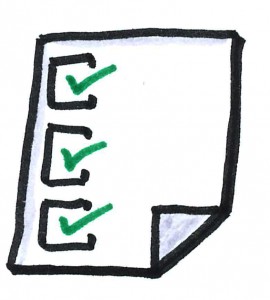There is much talk lately about NCSSFL-ACTFL’s Can-Do Statements and their role in measuring language proficiency. For those of you not yet familiar with them, the Can-Do’s are checklists of “I can” statements that describe what an individual should be able to do with the language at each proficiency level (Novice, Intermediate Low, etc.). The question that many of us have when reading these long checklists is: what do I actually do with these statements in my class to help my students speak better?

Can-Do’s for self-assessment tasks
Involving students in the learning process by letting them self-assess their performance increases awareness of their own strengths and weaknesses, and motivates them to work towards specific goals. The Can-Do Statements work as specific performance goals, are written in student terms, and are easily measurable.
One of my favorite in-class Extempore activities is a type of self-assessment that I call S-T-R (Speak, Transcribe, Reflect). For this exercise, students are given a simple task, usually with just one prompt. I use one of the most limiting settings in Extempore: only 15 seconds to read the prompt, two minutes to talk, and no option to re-record. The point is to get their most spontaneous responses to the prompt. Once they’re done recording, students individually transcribe their two minutes of speech verbatim, including pauses and errors. The third step is to reflect on how they speak. This reflection can take different forms, but one that students particularly like is when they have Can-Do Statements to structure their reflection.
Can-do’s to guide student’s reflections on learning
For example, to assess students’ presentational skills on familiar topics, I may ask them to describe what they liked to do for fun when they were younger. Then, to self-assess I ask them to compare their own performance against different Can-Do Statements that reflect different proficiency stages. I start with some of the basic statements in the ACTFL’s website (for example, “I can list my favorite free-time activities and those I don’t like”, “I can describe a childhood or past experience”) and then I add my own Can-Do statements that represent the levels of complexity and accuracy that I want my students to work on (“I can do it in complete sentences”, “I can do it with few grammatical errors”, “I can do it with more than four different expressions of likes and dislikes”, etc.). After going through the task-specific Can-Do Statement checklist (usually 6 or 7 statements), students can better verbalize how well they did on this particular task and what they need to work on.

Can-do’s and spontaneous speech
Since the Can-Do Statements serve as performance goals and checklists for students to self-assess their progress, it's best to use them in tasks in which students are encouraged to produce more natural, unscripted speech. With Extempore, students can easily record these tasks during a few minutes of class time and use them as evidence to support their Can-Do Statements and self-assessments. Unlike traditional 1:1 interviews that students never listen to after their performance and are rarely used for self-reflection, having their oral assessments stored in the Extempore App lets students easily reflect on how they are doing and keeps track of their progress.


